by Larry Williams | Feb 22, 2013
Fertilizing your lawn before the soil temperature is adequately warm results in waste of fertilizer and possible lawn injury.
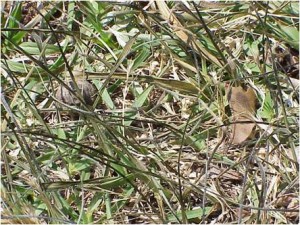
Close up of cold injured lawn grass blades
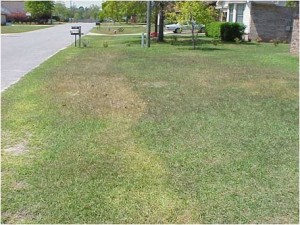
Lawn cold injury from too early fertilizer application
Despite the fact that you can easily force your lawn to turn green early with many of the high nitrogen fertilizers, it’s a false sense of accomplishment. That new green growth is dependent on the availability of other elements, some of which are poorly available under cool soil temperatures. Iron, for example, is not readily available while the soil is still cool. This is exactly what happens when your lawn begins to turn bright yellow after being fertilized too early. In other words you’ve induced or caused a nutrient deficiency by fertilizing too early. It’s simply a matter of the soil being to cool to allow the roots to take in the needed iron to support the new growth that you’ve caused from fertilizing too soon.
There are other needed nutrients, such as potassium, which are not readily available under cool soil temperatures. As a result, some of these fertilizer elements leach below the root area before grass-roots are in a position to use them. As a result of fertilizing too early, you’re wasting fertilizer and money that’s washing away and not being used by your lawn. Waiting to fertilize during more favorable soil temperatures allows for more efficient use of the fertilizer and less waste.
In order for our lawn grasses to efficiently use fertilizer, consistently warmer nights are required. So why not wait until mid April to fertilize? You’ll waste less fertilizer, save money and have a healthier lawn in the process. It’s a win, win, win situation.
by Eddie Powell | Feb 15, 2013
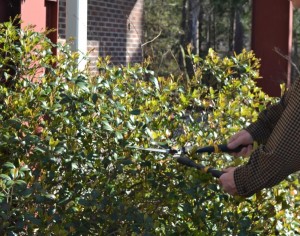
As spring approaches, many gardeners get out the pruning shears and prune everything in sight. That might not be the best course of action! Take a look at these tips for flowering landscape shrubs to learn more about pruning techniques that will maximize amount of bloom.
Why Prune?
• Control plant size or form
• Remove damage (mechanical, disease, etc.)
• Prevent potential damage (overlapping branches, poor crotch angles, diseases, etc.
• Stimulate new growth (rejuvenate old plants, fill bare areas, increase flowering, etc.)
When to prune:
• Corrective pruning due to injury or dead tissue should be done as soon as evident.
• Avoid pruning from August 15 until plants are dormant.
• Most pruning should be done during the dormant season or immediately after flowering.
Rules of thumb:
• The “May Rule”.
• May defined if the plant blooms before May 1, prune immediately after flowering has ended (flowers produced on old wood or last year’s growth: Azaleas, Forsythia, etc.)
• If the plant blooms after May 1, prune during the dormant season (flowers produced on new growth: Crape Myrtles, Lilac Chaste tree, etc.).
• As with any rule there are exceptions: Oak leaf Hydrangea.
General rules of Pruning:
• Local in affect (usually within 6” of cut).
• Cuts should be made ¼” above a bud or to a crotch (Lateral branch).
• Cuts should be made at angles.
Pruning Equipment: (Make sure blades are sharp)
• Hand Snips (for small branches)
• Loppers (branches > 0.75” in diameter)
• Pruning Saw (limbs > 1.5” in diameter)
• Shears (for a more formal look)
• Pruning Knife (for clean-up)
Safe Pruning Principles:
• Keep equipment clean and in good repair.
• Appropriate, properly fitted safety equipment for job (eye and ear protection, no loose fitting clothes, etc.)
• Keep equipment within your control zone. Don’t over extend, know the limitations of your equipment and yourself.
• Know your surroundings (overhead utilities, other workers, etc.).
• Be able to identify Poison Ivy, Poison Oak, and other skin irritants.
Quick Tips to Remember:
• Pruning: Remove dead wood and seed pods annually during the dormant season.
• Size control should be done by cultivar selection, not by pruning.
• To promote a second set of flowers, prune away faded or spent flowers throughout the season.
For more information, click here for a UF / IFAS Extension publication on proper pruning techniques.
If you have any questions contact your local county extension agent.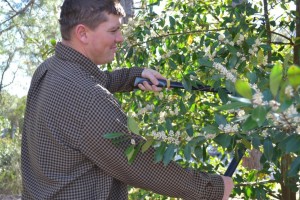
by Eddie Powell – Walton County Extension Horticulture Agent
by Matthew Orwat | Feb 15, 2013
According to the National Weather Service a mild freeze is predicted for Northwest Florida this weekend, specifically Saturday night to Sunday morning. Washington County Horticulture extension agent Matthew Orwat says,” While mature, dormant Satsuma trees are cold hardy down to 14° – 18 °F, young trees need protection if temperatures dip into the upper 20s.”
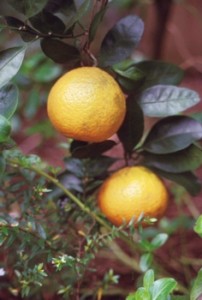
Photo Credits David Marshall
Here are a few techniques to protect young citrus trees from late-season freezes:
- Wrap the trunk with commercial tree wrap or mound soil around the base of the tree up to 2 feet. This will protect the graft of the young tree. Thus, if the branches freeze the graft union will be protected.
- Cover the tree with a cloth sheet or blanket. For additional protection, large bulb Christmas lights may be placed around the branches of the tree. This will increase the temperature under the cover by several degrees. Be sure to use outdoor lights and outdoor extension cords to avoid the potential of fire.
- Water your Satsuma trees. Well watered trees have increased cold hardiness.
- Frames may be installed around young trees to hold the cover. This option keeps the blanket or sheet from weighing down the branches.
- For homeowners with lemon, lime or other less cold hardy citrus, micro-irrigation is an option. This practice will protect citrus trees up to 5 feet, but must be running throughout the entire freeze event. For additional information click here.
- Always remember to remove cold protection once the temperature rises so that the trees do not overheat
- Do not cover trees with plastic tarps, these will not protect the tree and can “cook” the tree once temperatures rise.
Please see the following publications by retired UF / IFAS Extension agents Theresa Friday and David Marshall for additional information regarding freeze protection of citrus.
by Matthew Orwat | Feb 8, 2013
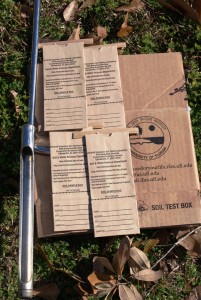 To be sure, this week’s warm spring-like weather and refreshing rains have reminded many gardeners that it is about time to prepare this year’s vegetable and flower beds. Before home gardeners fertilize or lime, however, it is vital to understand the condition of the soil.
To be sure, this week’s warm spring-like weather and refreshing rains have reminded many gardeners that it is about time to prepare this year’s vegetable and flower beds. Before home gardeners fertilize or lime, however, it is vital to understand the condition of the soil.
One of the easiest methods to assess the condition of a gardens soil is to obtain a soil test. Soil tests effectively determine the pH and nutrient levels of the soil in a given area. It is essential that the test be collected correctly so that it accurately reflects the nutrient levels in the garden. All that is needed to take an accurate soil sample is shovel or soil probe, and a plastic bucket. Metal buckets will contaminate soil sample results, so a plastic bucket is an absolute requirement. To collect your soil sample, follow these guidelines:
- Identify the garden area(s) to be sampled. Use one soil sample bag for each area. Uncharacteristic or problem areas (such as depressions, etc.) within the garden should be sampled separately.
- Using a shovel (or soil probe), remove soil from a number of locations. The more soil collected from the sample area, the more accurate the results will be. Soil should be removed from the top 6 inches.
- Discard any plant material (such as leaves or roots) and deposit the soil into the plastic bucket. When you are done collecting soil, mix all the soil in the bucket to ensure it is well blended. You will have much more soil than you need to fill the sample bag, but a well-mixed representative sample is important for good results.
- Spread the soil from the bucket onto newspaper and allow it to dry thoroughly. This may take up to 24 hours. A dry sample is very important because moisture may affect the results.
- Once dry, pack approximately 1 pint of soil into the soil sample bag (filled to the dotted line) These bags are available free from your county Extension office..
The best soil test value is the $ 7.00 soil test which includes analysis of phosphorus (P), potassium (K), calcium (Ca), and magnesium (Mg) in addition to soil pH and liming requirement. The proper form should be filled out and mailed to the University of Florida with the soil sample and payment. Results will usually be sent back within 1-2 weeks. Click here to view a sample soil test report.
The soil sample report will include lime and fertilizer requirements. Remember that the recommended fertilization rates in the report are in pounds of nutrient, not pounds of fertilizer. For example, if it is recommended that the home gardener apply 2 pounds of nitrogen 1000 square feet and their fertilizer analysis is 10-10-10, they would need to apply 20 pounds of fertilizer. This is because 10-10-10 fertilizer contains 10% nitrogen.
For more information, consult your local county extension office, visit the UF/IFAS Extension Soil Testing Laboratory website, or the UF/IFAS publication Soil Sampling or Testing for the Home Garden.
by | Feb 8, 2013
Magnolia flowering has been exceptionally good this year. Mild temperatures have coaxed “Japanese” magnolias into bloom as much as 4 weeks early. Fortunately the absence of hard freezes (so far) has allowed us to fully enjoy magnolias’ beautiful flowering.
Most years we are not so lucky. Flowers are often damaged by late winter or early spring freezes. The best way to avoid such damage and enjoy a complete flowering season is to plant varieties that bloom later than most. If this year’s glorious magnolia flowers inspire you to add a magnolia or two to your garden, consider one of the following improved, later-blooming magnolia cultivars; all are generally available at better garden centers throughout the area:
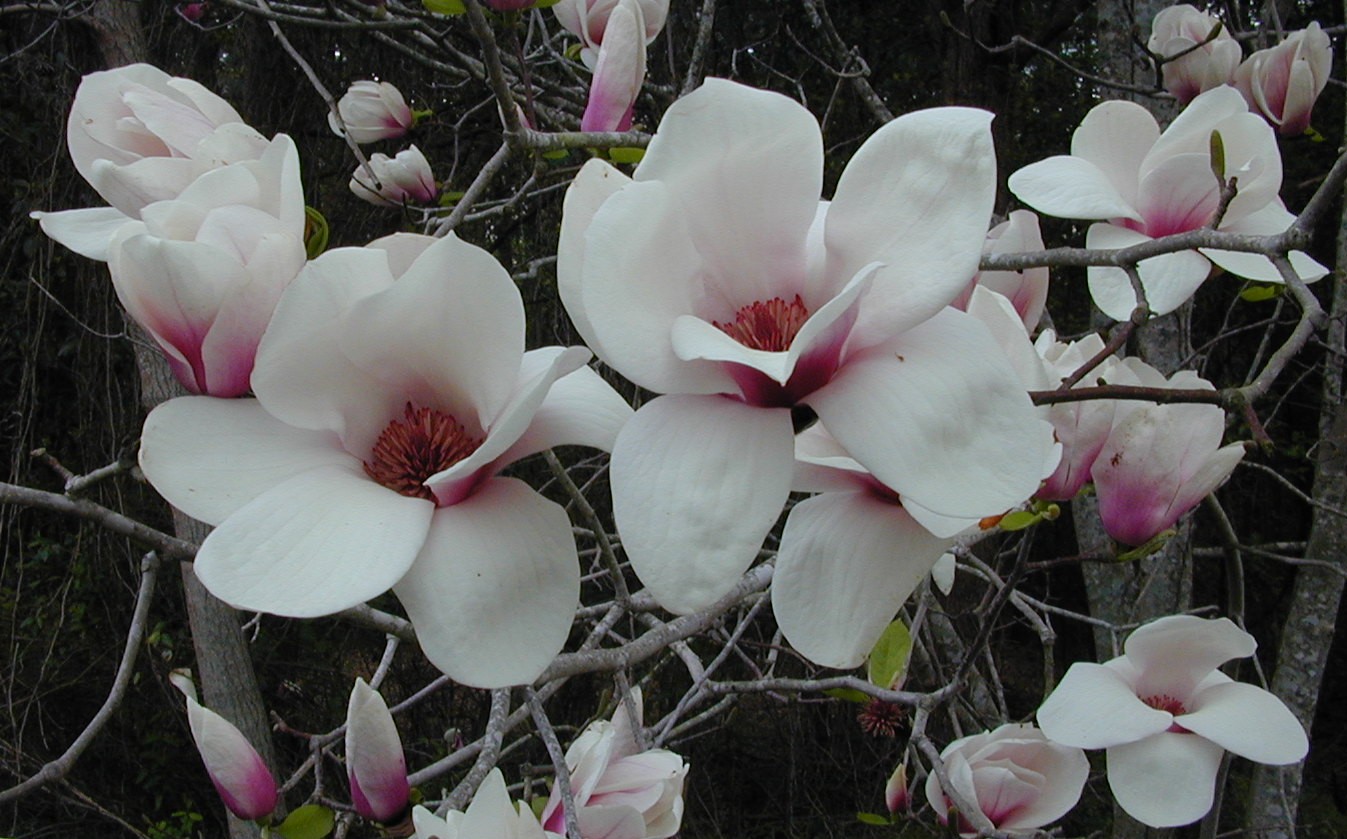
‘Jon Jon’
‘Jon Jon’ has large buds that develop into goblet-shaped flowers the first day, gradually opening as wide as 12 inches in diameter (though 8 inches is more typical). Flowers are creamy white with a reddish-purple blush at the base. ‘Jon Jon’ grows into a small tree about 20 feet tall. Peak bloom in north Florida typically occurs March 2, based on 10 years of flowering data at the University of Florida research center in Quincy, Florida.
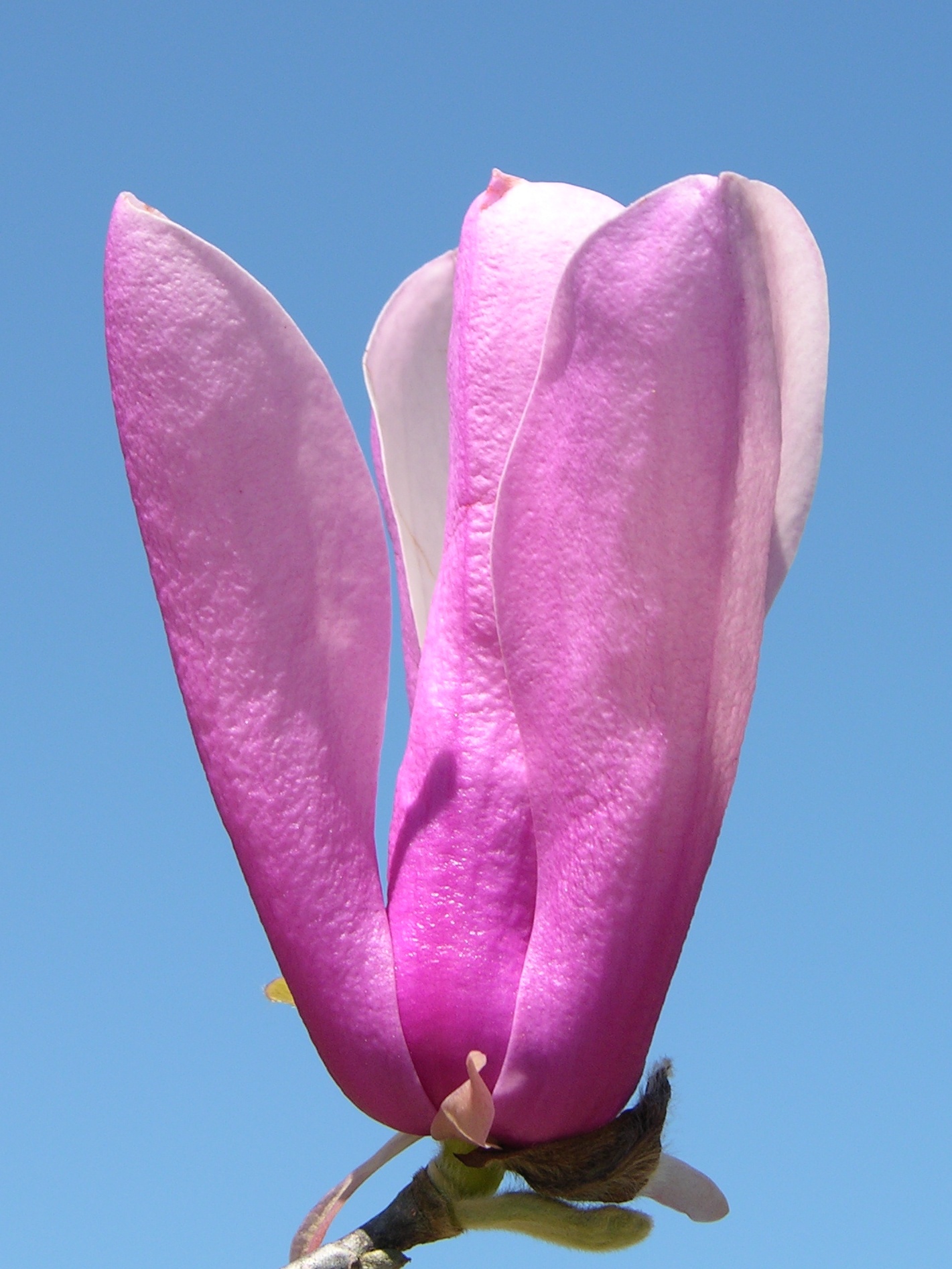
‘Jane’
‘Jane’ has red-purple buds that open into cup-shaped flowers 3 – 4 inches in diameter, pinkish-purple on the outside and white inside. It grows as a large rounded shrub or small rounded tree. Based on UF-Quincy data, peak flowering occurs March 17.
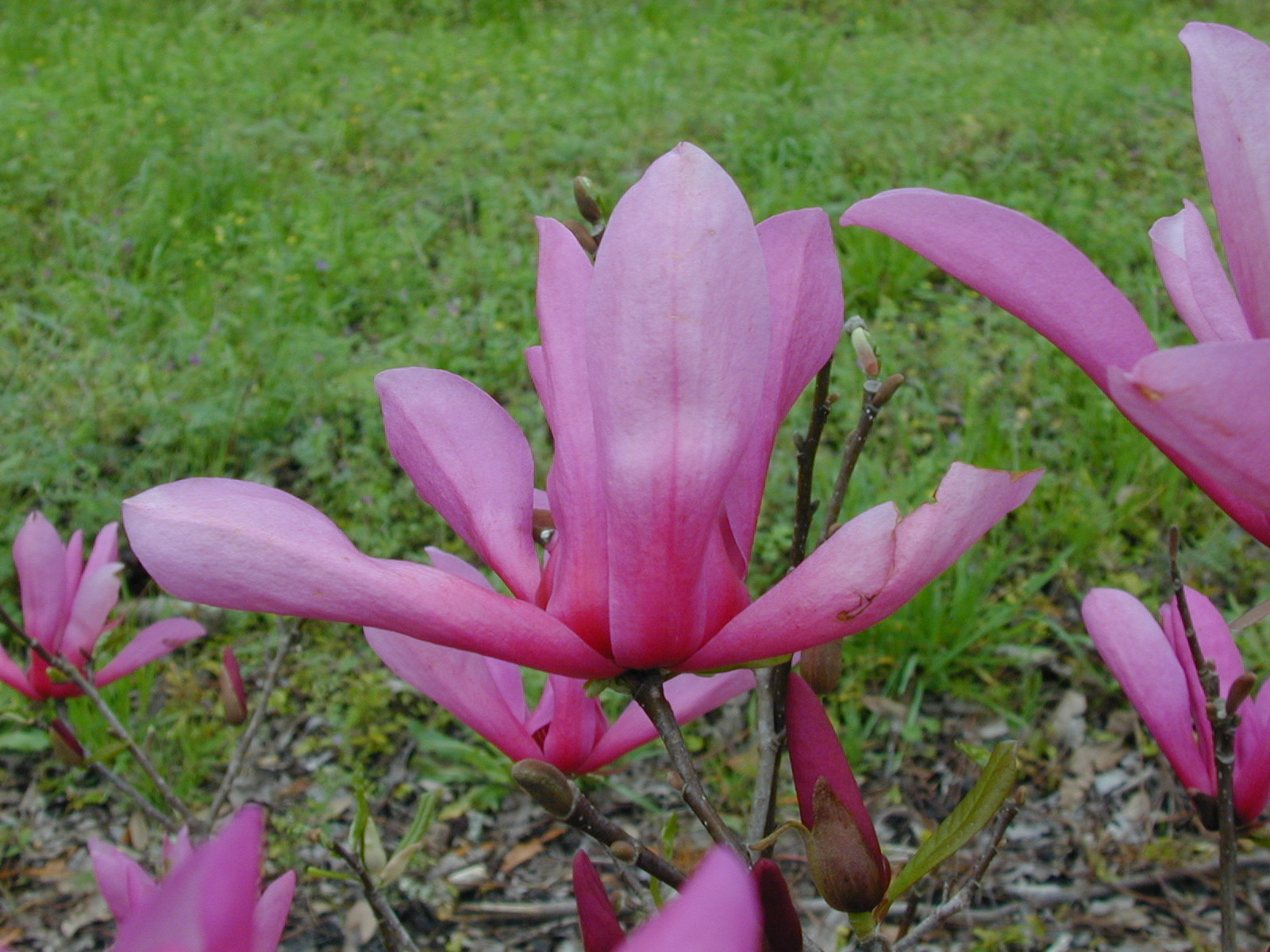
‘Ann’
‘Ann’ has rich, dark red-purple buds that open to red-purple flowers about 3 inches in diameter. A sister of ‘Jane’, ‘Ann’ similarly grows as a large rounded shrub or small tree. Peak flowering is March 20. Amazingly, ‘Ann’ produces flowers sporadically all spring and summer!
When purchasing a magnolia, look for a healthy plant with evenly spaced branches. A container-grown plant can be slipped out of its pot to inspect the roots. Healthy roots are yellow-white, whereas diseased roots are brown to black and often have a sour odor.
Magnolias prefer a spot in the garden that receives full sun to light shade, ideally with shade from the hot afternoon sun. If possible, avoid exposed, windy locations because strong winds can damage large flowers and the typically brittle branches. Magnolias grow best in moist, well-drained, slightly acid soils but neutral to slightly alkaline soils are also suitable for growth. Magnolias are adaptable to clay, loam or sand soils, but grow poorly in wet or poorly drained soils. Well-established plants can be moderately drought tolerant. Add a magnolia to your yard today and you can enjoy spectacular spring flowers for years to come!
For more information, visit http://edis.ifas.ufl.edu/ep453, ‘Jon Jon’ Magnolia: A Late-Flowering Deciduous Magnolia for Northern Florida, or http://www.magnoliasociety.org/, the website of Magnolia Society International.
(Gary W. Knox, University of Florida/IFAS North Florida Research and Education Center, 155 Research Rd., Quincy, FL 32351; gwknox@ufl.edu)










